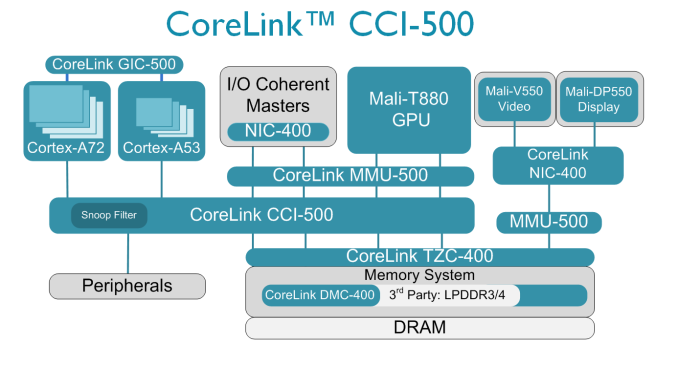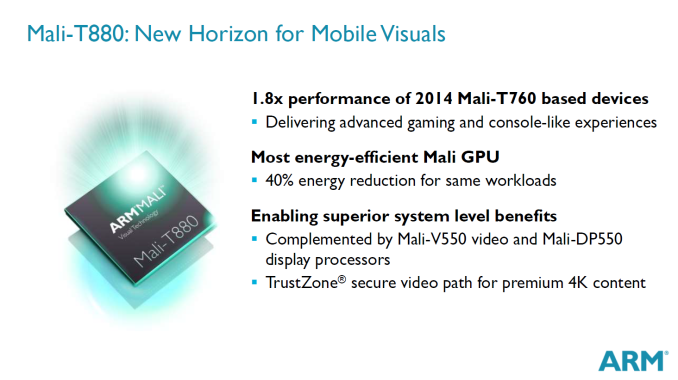ARM Announces Cortex-A72, CCI-500, and Mali-T880
by Andrei Frumusanu on February 3, 2015 5:30 PM EST- Posted in
- Smartphones
- Arm
- Mobile
- Mali
- Cortex A72
- CCI-500
- Mali T880

Today ARM is announcing three brand-new premium IP designs targeted at high-end mobile SoCs. We're still only starting to get widespread commercial availability of ARM's latest generation of SoCs, which includes the Cortex-A57 in big.LITTLE configuration coupled with the A53 as little cores, and the newest T760 Mali GPUs. But, while those designs are still ramping up through offerings from Samsung, Qualcomm, HiSilicon and co. this year, ARM isn't staying still and already looking forward to 2016 and beyond.
Cortex-A72 - a new high end core
At the center of today's announcements a new high-end performance core which succeeds the A57 in flagship devices. ARM was very vague about the architectural characteristics of the new design, disclosing for now only estimates of the chip's performance and power targets. ARM promises a 3.5x sustained performance increase over the A15 generation of SoCs while remaining in the same power budget. One has to note that we're talking about performance targets on TSMC's 16nm FinFET+ node versus previous nodes such as 28 and 20nm, which in itself should bring large clock and power advantages.
The A72 targets roughly 1.9X the sustained performance of current 20nm A57 SoCs, meaning the Exynos 5433 and the Snapdragon 810 can be taken as the base for comparisons. ARM doesn't yet mention peak performance so we may be talking about overall power efficiency gains that enable future SoCs to throttle much less. ARM will be divulging more information on the architecture of the A72 in the coming months, and we're hoping to have a better picture on the actual IPC and efficiency gains of the new flagship core by then.
The Cortex-A72, being a "big" core, can be partnered up with the already existing A53 LITTLE core architectures. ARM has said in the past that the A53 took in-order designs to new heights, and while work on a successor is underway, it seems that for now we'll be sticking with the A53 architecture for a while longer.
HiSilicon, MediaTek and Rockchip are listed among more than then launch partners which have already licensed the Cortex-A72 processor, so expect to see a variety of vendors offering the new ARM IP in 2016.
CoreLink CCI-500 SoC interconnect
It's been over 3 years since ARM initially announced their CCI-400 (Cache Coherent Interconnect), which saw widespread usage as the corner-stone technology enabling big.LITTLE heterogeneous multiprocessing in all consumer SoCs from the Exynos 5410 to the latest Snapdragon 810. While ARM also offered high-end alternatives such as the CCN-5XX (Cache Coherent Network) range of interconnects, these were targeted more at server-applications and not meant for mobile SoCs in smartphones or tablets.
The CCI-500 is a large upgrade over the CCI-400 as it introduces a variety of new functionality over its predecessor. The largest change in functionality is the addition of a snoop filter on the interconnect itself. Until now snoop control was only possible between CPUs within a single cluster. The addition of a snoop filter on the interconnect allows for power efficiency benefits as the amount of transactions when doing cache lookups is decreased, enabling both reduced overhead on the interconnect and also higher idle residency times on the CPU cores. This reduced overhead also frees up memory bandwidth on the interconnect, and ARM claims this enables for 30% better memory performance on the CPU ports.
The new interconnect also doubles up on its system bandwidth: We now have twice the number of ACE (AXI Coherency Extension) ports, enabling usage of a maximum of four CPU clusters (instead of the two that are possible with the CCI-400). We'll be continuing to see the usage of only two clusters in mobile designs, but the new IP gives licensees the flexibility to deviate according to their needs.
The increased bandwidth and numbers of ports on the interconnect also opens up the possibility of quad-channel memory controllers, resulting in 128-bit memory buses. The Snapdragon 805 was the first mobile product to feature such capability, although Qualcomm used a non-cache-coherent interconnect in their design.
Mali T880 GPU
Lastly, ARM also announced a new member of the T800 series of Mali GPUs. In addition to the T820, T830 and T860 comes the T880. ARM was again light on details of what this new configuration brings, only promising a 1.8x increase performance over 2014 Mali T760 GPUs and a 40% reduction in energy consumption for the same workloads.
With today's announcements, ARM appears to be addressing its weaknesses in mobile SoCs by focusing on sustained performance and efficiency of its big core architecture. We also have the much needed upgrade in the memory/interconnect subsystem and an expansion in its GPU IP offering.
Source: ARM
















49 Comments
View All Comments
name99 - Wednesday, February 4, 2015 - link
You are aware of this thing called Moore's Law, right?...And what is your complaint against "flooding the market with cheap Cortex-A7 cores"? You are in a position to be able to pay, I don't know, $600 for a really nice phone; but there are plenty of poor people out there who are thrilled to have a smartphone that cost them only, maybe $30 or so. I met some of them in Myanmar and a cheap smartphone is the first electronics, hell the first nice thing, they have ever owned. China and MediaTek are doing god's work by bringing so much happiness to so many poor people.
V900 - Thursday, February 5, 2015 - link
Yes, screw stuff like clean water, paved roads, a stable electricity supply 24/7 and all those other things that actually HELP people in third world countries.What they really need is a shoddy 30 dollar handset, that they can play Candy Crush on for a few hours, and then stroke lovingly the rest of the day/week when there isn't power in the village, and they don't want to walk 15 miles to get it charged.
MrSpadge - Wednesday, February 4, 2015 - link
A72 seems to provide an impressive gain over A57, after subtracting something process related gains. Every year I want better SoC's to be put into a Lumia 1020 successor, yet my current phone still doesn't want to fail so I keep waiting for price drops or better hardware.haukionkannel - Wednesday, February 4, 2015 - link
two A72 cores seems to be what would be sensible to have. Not too much power to eat the battery, but so much punch that all everyday applications should be blinding fast...But I am afraid that we get 8 core little big and maybe four core variants... The four core is not so bad, but for me two fast would be better...
Tams80 - Wednesday, February 4, 2015 - link
For the 1020 successor (if there even is one), they should go back to the 808 PureView design of having a DSP, rather than using a SoC core.twotwotwo - Wednesday, February 4, 2015 - link
Seems needed. Intel and Apple are busy, and the A15 seemed to get relatively few design wins (blame Qualcomm and Apple). Wonder how long it will take to get in products, though. 2017?name99 - Wednesday, February 4, 2015 - link
WTF are you talking about? There is a LONG list of A15 based SoCs. You just don't hear about them any more because sites like AnandTech tend to review the newest fanciest phones.And ARM claims there will be A72 devices shipping in 2016. This seems plausible. I expect Apple will use up all the 16FF+ capacity this year for A9s, but that capacity will start to be available for other vendors in early 2016.
ruturaj1989@gmail.com - Sunday, March 8, 2015 - link
Surprisingly it's coming out this year only.Pork@III - Wednesday, February 4, 2015 - link
I predict even more heated mobile devices :D